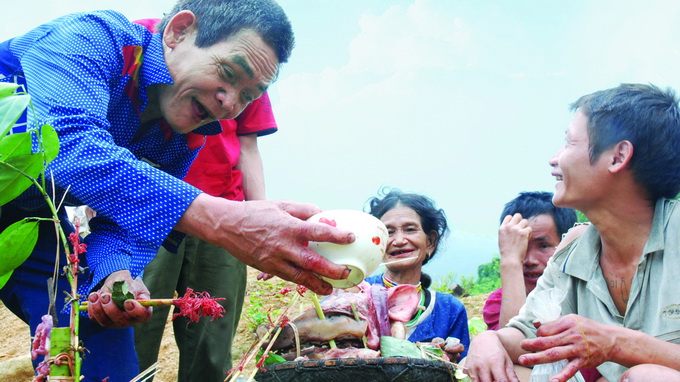Members of two ethnic community groups native to the Truong Son mountain range, which runs parallel to the Vietnamese coast, retain their long-standing practice of honoring the holy monkey with year-end festivities.
The Kinh people, who make up the majority of the Vietnamese population, celebrate their Tet (Lunar New Year) around February each year.
The upcoming Tet, which begins on February 8, ushers in the Year of the Monkey, as indicated in the lunar calendar.
Meanwhile, members of the Xe Dang and Ca Dong ethnic minority communities indigenous to the foggy Truong Son range which runs from north to south as the backbone of Vietnam have their own way to honor their mascot: the monkey.
The people officially reside in Kon Plong District in the Central Highlands province of Kon Tum.
The time-honored practice is among the few surviving traditions among the ethnic minorities residing atop or in the vicinity of Truong Son Range.
According to village elders, the ritual of venerating the holy monkey stems from the peoples' habit of leaving their granaries on paddy fields after harvest.
Herds of monkeys would sneak on and tamper with them, leaving the granaries wide open and vulnerable to birds and other grain-eating animals.
When their rice at home ran out, the Xe Dang people would ascend the mountain to fetch some rice home, only to find that their granaries had been emptied.
The starving people then made offerings to 'Yang Khi' (Monkey God) in the belief that the animal deity would protect their crops from damage.
The practice of paying reverence to the sacred primate with 'Tet Khi' (Tet of the Monkey) then came into being.
Festivities generally kick off in early November each year and last around two or three days.
The exact days of the celebrations, however, vary from one family to another, as they are free to select their own auspicious days within that month.
During the festive month, trails along villages of the Ca Dong ethnic people, who concentrate most in Ngoc Tem Commune, are dotted with bamboos, which are topped with pieces of cloths stained with the blood from sacrificed pigs and chickens.
 The thread tying ceremony, which is the most significant ritual of 'Tet Khi'. Photo: Tuoi Tre
The thread tying ceremony, which is the most significant ritual of 'Tet Khi'. Photo: Tuoi Tre
Unlike the King people’s Tet, Xe Dang’s and Ca Dong’s 'Tet Khi' is of religious significance rather than being a festive occasion.
A Bep, an elder of Diek Not Village, nestled in Ngoc Tem Commune, revealed that households throw their own celebrations, with the dates fixed by the families’ senior members.
One particular day, A Ben, one of the villagers, and his family were about to celebrate 'Tet Khi.'
His three sons who live with their wives and in-laws in other villages were summoned.
The previous morning, they slaughtered a nine-kilogram pig, whose head, entrails and blood were reverently placed on a banana leaf later.
A Ben’s wife had also cooked a pot of the Xe Dang people’s signature rice and made cakes from the staple before wrapping them in 'dong' leaves.
'Dong' leaves are also used by the Kinh people to wrap their 'banh chung' (square glutinous rice cake), an indispensable delicacy in Tet meals for most families.
As showtime came, A Ben respectfully carried a tray of offerings to the front of his home, chanting enigmatic prayers in the Xe Dang dialect and holding a 'neu' (bamboo pole) in his hand.
Then he flung the 'neu' hard so that it stood straight on the ground, before his three sons sprayed the pole with the pig’s blood and scattered rice and salt around to invite the Monkey God to return and consume the offerings.
 The year’s first batch of rice fetched from the granaries atop the mountains is pounded carefully and shared among family members. Photo: Tuoi Tre
The year’s first batch of rice fetched from the granaries atop the mountains is pounded carefully and shared among family members. Photo: Tuoi Tre
'Tet Khi' is also a special occasion for family members to bond with one another and pray for a year full of prosperity and blessings.
The most significant ritual of 'Tet Khi' sees fathers tying threads stained with pig blood around the wrists of their wives, children and grandchildren and smearing their heads with the blood in hopes that their dearest ones will be protected by the Monkey God in the coming year.
Following the solemn rituals, healthy women are tasked with ascending the mountains and fetching home the first batch of rice for the year.
The rice is dehusked and pounded painstakingly before being cooked and shared among the family members during the year’s first meal.
After savoring the rice, they cozily serve one another pork and cakes and gulp down traditional wine to excess.
'Tet Khi' usually does not end until at least two or three days later, during which time most villagers remain under the influence, and totter or lie about their homes legless.
Like us on Facebook or follow us on Twitter to get the latest news about Vietnam!






















































